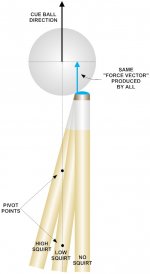I am not buying it, at least as I understand what is being stated.
Tip diameter preference is a function of shaft diameter preference, not a function of accuracy nor does it contribute to or detract from accuracy.
Thin shafts flex more. We have seen the advent of thinner shafts with the emergence of LD. Switching to a thinner shaft requires less compensation for cue ball deflection and I believe that is why we see people miss more or lose accuracy when switching to thinner shafts. It isn't a function of the tip diameter so much as a change in the flexibility of the shaft and hence a change in deflection.
All else being equal IMHO the consistency and accuracy of the stroke necessary is the same, in practical terms, regardless of tip diameter.
Tip diameter preference is a function of shaft diameter preference, not a function of accuracy nor does it contribute to or detract from accuracy.
Thin shafts flex more. We have seen the advent of thinner shafts with the emergence of LD. Switching to a thinner shaft requires less compensation for cue ball deflection and I believe that is why we see people miss more or lose accuracy when switching to thinner shafts. It isn't a function of the tip diameter so much as a change in the flexibility of the shaft and hence a change in deflection.
All else being equal IMHO the consistency and accuracy of the stroke necessary is the same, in practical terms, regardless of tip diameter.
